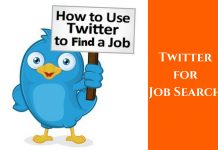One of the main reasons why many job seekers do not land their dream jobs is because of they not aware of the basic information needed when applying for the job. This is one of the most common mistakes that many job applicants unknowingly make which closes their way towards best job opportunities…

To overcome such mistakes, one should always try to research and understand the latest technological trends and also understand a statistical rate of how the industry treats job seekers and potential employees. A very good approach is to learn and analyze data and understand why many job applicants are not getting the job.
If you have a couple of minutes to spare every day, then try to study about the statistical data related to employment and recruitment process that each company releases and get to know why there is such a huge competition in the job industry.
Moreover, understanding such difficulties and learning how to tackle those makes you more polished as a jobseeker and more desirable for many companies as a potential employee. Here are a few factors that will give you an idea of how competitive the job industry is:
Job Search Statistics Everyone Needs to Know:
These are a few recruitment statistics every employee should know when doing a professional job search. The following mention is a few tips on job trends and employment statistics that every recruiter checks when hiring employees.
1. Competition based on resumes:
- One of the main problems that every candidate has to tackle is to make sure that their resumes stand out from the generic applicants. Statistical surveys have shown that irrespective of the companies and the jobs posted, for each job opening, an average of 250 job applications sent to a particular vacancy every day.
- Moreover, the first job application sends to the company in roughly about 2 minutes after the job posted in many job sites and the company website itself. This shows how competitive many job seekers are in many fields, especially in the corporate industry.
- Also, if you chose to send a job application to the more popular job sites such as LinkedIn and Monster.com, your resume will have to fight through stiff competition. Mainly because nearly 427,000 jobs issued daily on many popular job sites every week. Simply put, many popular job sites get at least half a million job applications every week for job posts on their sites.
2. Try to learn more about the hiring range that each company expects:
In the corporate industry, many recruiters use an estimate of how many job applications they have to yield to get single job recruitment. They call it as job funnel.
Seeing it in the perspective of a job applicant, this job funnel shows your chances of getting the job and how much probability is present for your application to select. It also shows the amount of success rate that each applicant has in completing the steps involved in the selection process.
- For instance, for a specific job, after posting the job, consider that 1000 job seekers will see the job post, nearly 200 will start the job application, out of which 100 of them will successfully finish the application process.
- Out of this 100, 75 resumes selected by continuous screening and selecting by the recruiter or a hiring manager.
- Out of the 75 resumes passing the first stage, nearly 30 of them will notice by the head recruiter out of which 4 – 6 resumes which consider the aptest resumes for the job are selected for the job interview process.
- Then, out of these 6, at least 5 people will be called for the interview process. Out of these 5, let’s say 2 of them pass the interview process and in the end, only 1 will be given the job.
This is how a normal selection process does in a corporate environment.
3. The amount of time the recruiters use to see your resume:
Even though many recruiters and hiring managers “claim” that they utilize at most 5 minutes for each applicant resume, in reality, this is not true at all. Recent studies have shown that many recruiters are exaggerating this fact.
In reality, many hiring agents spend a minute time of 6 seconds per resume. So these 6 seconds decides your future and decides whether or not you are suitable for the company. Detailed studies have shown that out of the 6 seconds they use to skim through the resume, 4 seconds, in reality, are used for checking the following 4 titles mentioned in the resume. These include:
- The job description and the job title
- Your educational qualifications
- Your previous experiences and the name of the companies that you have previously worked with
- The start and end dates of your previous jobs and your current employer.
This helps to narrow a more suitable candidate for the job under a short amount of time and helps to cancel out a large number of employees that not fit for the position. If by chance, you do not have the above-mentioned credentials, chances are your resume will be instantly placed in the rejection pile. The remaining 2 seconds used to check the other details such as hobbies and special abilities of the applicant.
Another interesting information is that less than 20% of the attached cover letter read by the recruiters. So try to include your qualifications inside your resume itself and not include it in your cover letter.
4. Job resume errors can be deadly:
- While editing and proofreading your resume, keep in mind that many recruiters do not even try to read resumes that have typos or simple errors.
- Recent surveys have shown that nearly 60% of the job applications instantly reject by the recruiter because they have typos in them. Nearly 50% of the recruiters will instantly reject a resume just because have spelling mistakes and typos. So keep in mind that small errors in resumes not only reduce your chances of getting the job but also provide the danger of being rejected at sight by the hiring manager.
- Another factor to be noted is that providing a silly or unprofessional email address also increases the rejection rate of résumé by an astounding 78%.
- Also, constantly displaying your employment dates which show you are currently unemployed also might get you rejected on the first go by the hiring manager. Since most of the corporate companies feel that being unemployed makes you unsuitable for the job.
5. Sending your resume in the correct format:
- Another main reason why many job applicants fail to get a job is that that most job seekers do not edit their resumes in the same structural format as prescribed by the company. This can lead to many problems such that the resume may fail to upload or it may not be scanned by the company system.
- However, sending a resume that is not in an affordable format as prescribe by the company can decrease your chances of getting your resume selected by a tremendous margin of 60%. If your resume is not in the correct format it can reduce your rating from 4 stars to a mere 2 stars, no matter how talented the job applicant is.
- Also, try to send your resumes in the correct digital file format. Most applicants tend to make the mistake of sending their resumes as a PDF file format, which makes it unsuitable to edit for the hiring manager.
- Keep in mind that, PDF file formats are very hard to scan into a job database which is controlled by the latest ATS system as they will fail to detect applications. The system will instantly reject applications which have PDF files attached to them.
- So, unless specified by the company, try to send your resumes in file formats like .doc and .docx to make sure that your application will be selected for the hiring process.
6. Unimpressive Social media profiles can be dangerous:
- Many recruiters tend to check professional social media profiles like LinkedIn as a reference to cross-check the information mentioned in the resumes and also to verify whether the included information is correct or not. LinkedIn profiles are used by recruiters to validate if the applicant or candidate is providing true information about their job qualifications, experience, and educational qualifications.
- Recent studies have shown that many recruiters try to spend at least 20 % of the allotted time checking your social media profile picture and also the details mention in the profile just to get a rough idea about you and your qualifications. They also use this method to make sure that whether or not you a suitable match for the job posting.
- So, while including your LinkedIn profile, make sure that you use a professional photograph of yourself as the profile picture and make sure that you keep your LinkedIn profile up-to-date even if you do not tend to use it often.
- Also, similar to that of resumes, if your LinkedIn account is not that impressive and has incorrect information in it, it can negatively affect the candidate’s chance of being selected for the job.
7. Try to apply for a position that you are capable of:
- One of the main reasons why there is a sudden influx of job applications when a job post is because, more than 50% of the candidates who apply for the position, are not able to reach the requirement consider for the job.
- The main reason being that many job applicants only spend roughly about 76 seconds to review the job description and job requirements and also study what the job is about. They do not try to think the bigger picture and decide whether or not they have the necessary qualifications required for the job.
- Out of the 76 seconds, nearly 60 seconds are sued to read the initial part of the job description that covers very little information about the job, their aims, and targets and what exactly is the job about.
- There are many claims present that an average job seeker spends at least 10 minutes looking for a job posted and tries to learn more about the job, but in this rat race, nobody does as claimed since as each second goes by, more and more applications are sent to the company. So to fit into the group most applicants do not even bother to know more about the job.
- Hence, this is one of the main reasons why there is a high rejection rate among job applications in the corporate industry.
8. Try not to apply for jobs application that closed:
- Always try to apply for jobs that are presently open and can accept resumes and applications from job applicants. This is because after the job application portal has been closed many recruiters do not even bother to look for candidate resumes that are stored in the company database. This is the main reason why many company and industrial database called black holes in the corporate industry.
- Another reason is that the ATS system tends to delete job applications that have sent after the deadline or before the job openings, your resume will be lost in the company database either way.
- So, try to send an application to job positions that are presently open and active, so that the ATS system can easily detect your resume and your resume may get the chance to be selected for the hiring process.
Because of the large number of obstacles and roadblocks, it is a sad reality that many famous hiring companies and corporations recruit only 3.5% of the total job candidates who have applied every year. So, to simply put there is only 4 out of 10 chance to get select by your company through online applications.
In the end, a resume will only land you an interview opportunity, how you perform during the interview is a whole another story and this decides whether or not you are the right pick for the company.











































